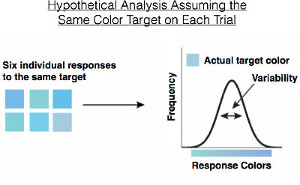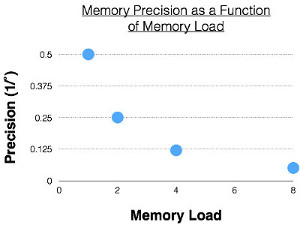지연 추정을 통한 시각적 작업 기억의 정밀도
English
Share
Overview
출처: 조나단 플롬바움 연구소 -존스 홉킨스 대학
인간의 기억은 제한적입니다. 실험 심리학은 역사의 대부분을 통해 기억의 개별적인 정량적 한계, 즉 사람이 기억할 수 있는 정보의 개별 적인 부분을 조사하는 데 초점을 맞추고 있습니다. 최근 실험 심리학자들은 더 많은 질적 한계에 관심을 갖게 되었습니다.
메모리 정밀도의 개념은 한 번에 직관적이고 애매할 수 있습니다. 예를 들어, 사람이 어머니가 어떻게 들리는지 정확하게 기억할 수 있다고 생각하여 전화나 군중 에서 즉시 어머니를 인식할 수 있다고 생각하는 것은 직관적입니다. 그러나 어떻게 그런 기억의 정밀도를 정량화 할 수 있습니까? 음성 자체와 메모리가 정확히 얼마나 비슷합니까?
기억과 작업 기억의 정밀도를 연구하기 위해, 특히 실험 심리학자들은 지연 된 추정으로 알려진 패러다임을 고안했습니다. 그것은 가장 자주 사용 되었습니다., 지금까지, 시각적 기억의 정밀도 공부, 특히 색상에 대 한 메모리, 그리고 메모리 한 번에 기억 하려고 더 많은 저하 하는 방법을 이해 하기 위해. 이 비디오는 지연된 추정을 사용하여 색상 작업 메모리의 정밀도를 조사하기 위한 표준 절차를 보여 주며, 더 많은 개체의 색상을 동시에 기억하려고 할 때 메모리가 어떻게 영향을 받는가에 중점을 둡니다.
Procedure
Results
The raw data on each trial are a response color and the true target color. That means the accuracy of a response on each trial can be quantified in terms of the angular difference between the right answer and the given answer. The colors—including the target and any response—make up a ring, occupying a total of 360°. When the answer given is exactly right, the angular error is zero, and the most it can ever be is 358°.
Because the colors all have equal luminance and contrast, responses can be collapsed across color targets—analyzed just like they would be in the hypothetical case of a single color repeated many times (Figure 4). The participant does not always respond with exactly that color. They also won’t respond with ones that are very different, so the expectation is that the exactly correct color is selected most frequently. Colors very similar to it should be selected less often, but still frequently. And very different colors should be selected almost never. This kind of pattern can be described mathematically in terms of a normal distribution—a bell curve. The correct answer should be the average response over many trials, but owing to imprecision in memory, there should also be some spread—quantifying the spread amounts to quantifying the precision of color working memory (Figure 4).

Figure 4. Hypothetical analysis assuming the same color feature on each trial. Supposing the blue labeled “actual target color” were the memory target over many trials, one would expect that color to obtain the most responses (i.e., the highest response frequency), with roughly a normal distribution for nearby blues. In other words, one should expect normally distributed responses with the actual target as the mean of the distribution. The variability in the distribution can supply a measure of memory precision.
In other words, angular error amounts to a color-agnostic way of characterizing the accuracy of each response.
The standard deviation of the distribution is the most often used measure to describe the spread of responses. A large standard deviation means that the distribution has a lot of spread and variability, a reflection of relatively imprecise responses. A small standard deviation reflects a tight distribution and precise memory. In this way, large numbers reflect imprecision and small numbers reflect precision, so scientists often use the inverse of the standard deviation (one divided by the standard deviation) to quantify precision. Now, large numbers designate precise memories, and small numbers designate imprecise memories.
When this experiment is conducted, researchers typically compute memory precision just as described, but independently for memory load, which refers to the number of color squares in a trial.
With higher memory loads, precision tends to decline (Figure 5), suggesting a tradeoff between how many things a person can store in memory and how precisely they can store those things.

Figure 5. Memory precision as a function of memory load, the number of color samples to remember in a given trial. Note that the unit of precision is inverse degrees, (1/°), since the unit of angular response error and its standard deviation is degrees.
Applications and Summary
Delayed estimation is a relatively new paradigm in experimental psychology, though it has become rapidly influential. In addition to investigating tradeoffs between memory capacity and precision, it can be used to compare the precision of memory systems, such as color working memory compared to color long term memory, and also to compare precision across individuals. For example, do interior decorators or painters tend to have more precise memory of color than lawyers or doctors?
Transcript
Experimental psychologists use the delayed estimation paradigm to assess the precision of visual memories, and how such memories degrade the more one tries to remember at once.
On one hand, human memory is constrained by the number of pieces of information an individual can remember-like how many items they need to restock the pantry-meaning that it is quantitatively limited.
Memory can also be limited in its precision. For example, a person can recognize their mother on the phone because they remember the sound of her voice. However, an individual’s “stored” memory of their mother’s voice may not perfectly match its actual, physical sound. Thus, memory can also be qualitatively limited.
The delayed estimation paradigm provides a way to evaluate the relationship between these quantitative and qualitative limits of memory.
This video demonstrates methods for investigating the precision of visual working memory, including how to design the stimulus and perform an experiment involving a delayed estimation paradigm, as well as how to analyze and interpret the results.
In this experiment, color provides an ideal stimulus to evaluate the precision of visual working memory, as it can be mentally represented in a continuous, non-linear spectrum known as a color ring.
Participants are asked to perform several trials during which they must remember a color stimulus. Each of these trials consists of three phases: sample, delay, and test.
During the sample phase, a randomly colored square appears onscreen for 500 ms. The square then disappears, leaving a blank screen.
Through this delay phase, participants are asked to focus on the empty screen for 900 ms, whereby the sample color must be remembered.
In the final test phase, a probe square-outlined in black and devoid of color-appears in the same position as the colored box shown previously.
Simultaneously, participants are shown a color ring consisting of 180 different colors and asked to select the region of the color ring that most closely resembles the original sample color.
Note that the color ring always appears in a random orientation, which ensures that participants can’t associate specific areas onscreen with certain colors.
To increase task difficulty, the memory load-the number of colored boxes shown in each trial-is varied from one to eight.
The dependent variable then is the precision of color working memory-how accurately participants remember the color or colors shown during the sample phase.
For a given sample color, participants are expected to vary within the “true” color range, but rarely choose colors that are drastically different.
As memory load increases, the precision of color working memory is likely to decrease.
To begin, choose a set of 180 colors with varying hues, which together form a color ring. Check that these colors demonstrate the same light intensity and contrast relative to the background color on the screen; this ensures that no single color will be more memorable to participants during the trials.
When the participant arrives, direct them to a computer and explain the procedure of the experiment.
Emphasize that when a specific region of the screen is probed, only the color of the box that appeared earlier in that same position should be chosen. In addition, instruct the participant to guess if they are unsure of a probed sample color.
To assure that participants understand the task, allow them to perform ten practice trials.
Once the participant understands the instructions, have them complete 480 experimental trials, with equal numbers of trials for memory loads between one and eight.
For each trial, record the memory load, the true colors of the sample boxes, and the colors the participant chose after the delay period.
To analyze the data independent of color, for every sample box shown and probed in a trial, calculate the angular error-the distance in degrees between the true and chosen response colors on the color ring.
If the participant remembered the exact color of the sample box after the delay period, the angular error should be zero.
For each group of trials dealing with the same memory load, create a frequency distribution curve, where the angular error is plotted on the X axis and frequency on the Y axis.
Once frequency distribution curves have been generated, calculate the standard deviation-the spread of values around the mean-for each.
Take the inverse of the standard deviation to generate a value representing memory precision. If this value is large, this is indicative of memory being precise for a group of trials.
To visualize the data, plot the calculated memory precision values as a function of memory load. Notice that as load increases, memory precision tends to decline, suggesting a tradeoff between how many things a participant can remember at once, and how precisely they can store this information.
Now that you know how to design and perform an experiment using delayed estimation, let’s look at how researchers are currently using this paradigm to tease apart different aspects of visual memory.
Until now, we’ve discussed how delayed estimation has been used to assess short-term working memory, in which a participant only has to briefly store a piece of color information for a single a trial. However, researchers could also investigate long-term color memory with this paradigm, evaluating it over much longer periods.
Furthermore, this paradigm can also be used to compare the precision of visual memory between different individuals, for example, visual-based professionals like interior designers, and potentially less-visual subjects, such as lawyers or doctors.
Finally, although researchers typically use the delayed estimation paradigm to evaluate memory for color, it can also be employed in neurocognitive assessments of other types of visual working memory-like that pertaining to shapes.
You’ve just watched JoVE’s introduction to delayed estimation. We’ve reviewed how to perform this method, as well as collect and analyze participant color memory data. Importantly, we’ve noted how this technique can help understand how the qualitative limits of human color memory can be influenced by quantitative factors.
Thanks for watching!
